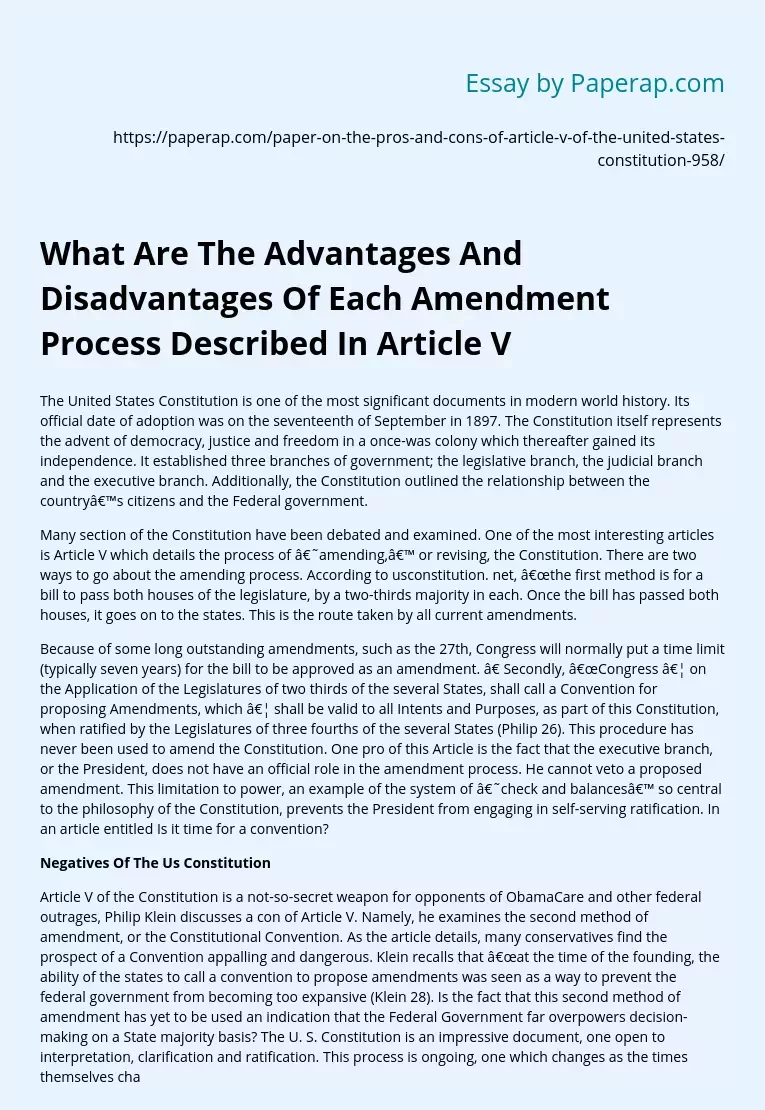Advantages and Disadvantages of Article V Amendment Processes
The United States Constitution is one of the most significant documents in modern world history. Its official date of adoption was on the seventeenth of September in 1897. The Constitution itself represents the advent of democracy, justice and freedom in a once-was colony which thereafter gained its independence. It established three branches of government; the legislative branch, the judicial branch and the executive branch. Additionally, the Constitution outlined the relationship between the country’s citizens and the Federal government.
Many section of the Constitution have been debated and examined.
One of the most interesting articles is Article V which details the process of ‘amending,’ or revising, the Constitution. There are two ways to go about the amending process. According to usconstitution. net, “the first method is for a bill to pass both houses of the legislature, by a two-thirds majority in each. Once the bill has passed both houses, it goes on to the states. This is the route taken by all current amendments.
Because of some long outstanding amendments, such as the 27th, Congress will normally put a time limit (typically seven years) for the bill to be approved as an amendment. ” Secondly, “Congress … on the Application of the Legislatures of two thirds of the several States, shall call a Convention for proposing Amendments, which … shall be valid to all Intents and Purposes, as part of this Constitution, when ratified by the Legislatures of three fourths of the several States (Philip 26). This procedure has never been used to amend the Constitution.
One pro of this Article is the fact that the executive branch, or the President, does not have an official role in the amendment process. He cannot veto a proposed amendment. This limitation to power, an example of the system of ‘check and balances’ so central to the philosophy of the Constitution, prevents the President from engaging in self-serving ratification. In an article entitled Is it time for a convention?
Negatives Of The Us Constitution
Article V of the Constitution is a not-so-secret weapon for opponents of ObamaCare and other federal outrages, Philip Klein discusses a con of Article V. Namely, he examines the second method of amendment, or the Constitutional Convention. As the article details, many conservatives find the prospect of a Convention appalling and dangerous. Klein recalls that “at the time of the founding, the ability of the states to call a convention to propose amendments was seen as a way to prevent the federal government from becoming too expansive (Klein 28). Is the fact that this second method of amendment has yet to be used an indication that the Federal Government far overpowers decision-making on a State majority basis? The U. S. Constitution is an impressive document, one open to interpretation, clarification and ratification. This process is ongoing, one which changes as the times themselves change and evolve. In relation to the ever-important Article V, Klein asks “if we don’t use a mechanism that the Founders designed for the purposes for which they designed it, then we’re not paying respect to their design (Klein 31). Perhaps we should consider ourselves doing a disservice to the founding fathers by not examining this aspect of Article V more carefully. Works Cited Klein, Philip. “Is it time for a convention? Article V of the Constitution is a not-so- secret weapon for opponents of ObamaCare and other federal outrages. ” The American Spectator Oct. 2010: 26+. Expanded Academic ASAP. Web. 14 Nov. 2011. U. S. Constitution Online. 2010. Steve Mount. 12 November 2011
Advantages and Disadvantages of Article V Amendment Processes. (2019, Dec 05). Retrieved from https://paperap.com/paper-on-the-pros-and-cons-of-article-v-of-the-united-states-constitution-958/

